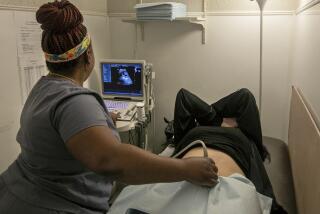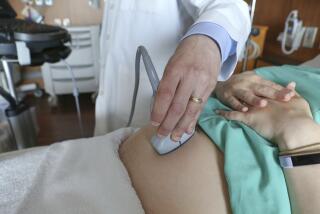Technique Promises Safer Detection of Birth Defects
- Share via
BALTIMORE — A safer, easier technique--involving only a tablespoon of a mother’s blood taken as early as eight weeks into a pregnancy--is being developed in Boston to test for hidden genetic disorders in a fetus.
Now, if women are troubled by the idea of possibly carrying a genetically damaged fetus in utero, there are only two ways to settle the question, and both are invasive and have a degree of risk.
Amniocentesis and chorionic villus sampling require withdrawal of fluid or tissue from areas close to the developing fetus. Neither can be done very early in the pregnancy. CVS has a 4% incidence of complications. Amniocentesis has a lower rate, 0.5%.
Dr. Diana W. Bianchi, a neonatologist-geneticist at The Boston Children’s Hospital and principal investigator in the research, described the new technique as “preliminary but promising” recently at the American Society of Human Genetics conference in Baltimore.
The technique, which could become available within a few years, would test for genetic disorders that have been identified at the DNA level--cystic fibrosis, sickle cell anemia, thalassemia, phenylketonuria, Duchenne’s muscular dystrophy--and possibly even screen for Down’s syndrome and other chromosomal disorders.
The test relies on the presence of fetal red blood cells that “leak” from the placenta--the structure in the uterus that nourishes the fetus--into the maternal bloodstream.
By examining these cells with highly sophisticated equipment, Bianchi and colleagues from the Harvard Medical School and the Howard Hughes Medical Institute also hope to find clues--or the answer--to why a fetus can grow without being rejected by the mother.
“If you transplanted a kidney into somebody, they wouldn’t accept it, but a baby is like a transplant,” she said. “We don’t know this--and this is only speculation--but if the constant leakage of blood from the baby into the mother somehow suppresses the mother’s immune system, it may be related to tolerance of the pregnancy.”
When researchers obtain the mother’s blood sample, they do a “density centrifugation,” which separates different cells according to their size and weight. Then they use an antibody that recognizes certain proteins on the surface of the cells.
The advent of a new tool, polymerase chain reaction, which amplifies genetic material in the sorted cells and can turn a few rare cells into millions of cells, has given the research a tremendous boost, the specialist said.
“We’re taking a tablespoon of blood from the mother and looking for the presence of the rare fetal blood cells that cross the placenta and end up in the mother’s bloodstream,” Bianchi said.
“Once we identify the cells as being fetal, then we can analyze the genetic material in the cells. So a cell from a fetus, whether it’s a blood cell, a chorionic villus sample or a skin cell from an amniocentesis, has the same genetic information.”
The benefit of the fetal cell sorting technique is that it poses “zero risk” to the fetus, as opposed to amniocentesis “where you’re sticking a needle into the womb,” or CVS, “where you’re sticking a catheter into the womb,” she said.
Before the technique can become available to pregnant women throughout the country, more work needs to be done. Technical factors have to be refined, but these are not “impossible problems,” according to Bianchi.






